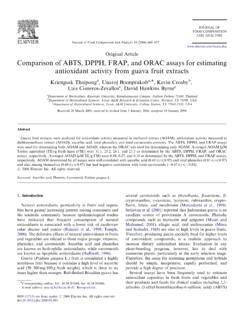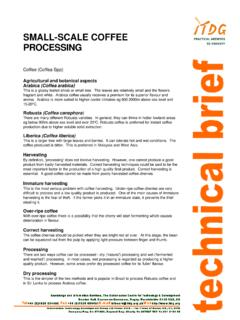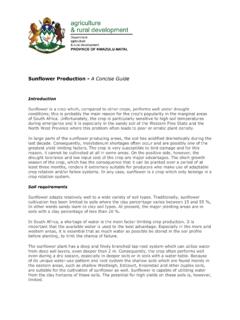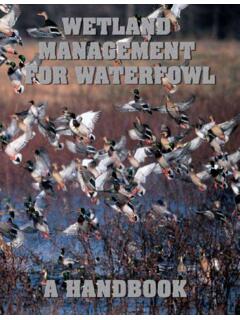Transcription of Texas Fruit and Nut Production Peaches - Texas A&M …
1 EHT-022. 11-13. Te x a s F r u i t a n d N u t P r o d u c t i o n Peaches Jim Kamas, Larry Stein, and Monte Nesbitt Extension Fruit Specialists, The Texas A&M University System P. eaches are the leading deciduous Fruit crop grown in Texas . An estimated 1 million trees are planted statewide, only half of which are planted in commercial orchards of 1. acre or larger. The demand for high-quality, locally pro- duced Peaches remains good, and the future appears bright for the industry. Selling fresh Peaches is more likely to be profitable if the orchard is close to a metropolitan center, where high-quality, tree-ripened Fruit com- mand premium prices (Fig. 1). The most limiting factor in orchard profit- ability is late spring frost, and growers should plan on losing one in six or seven crops even in the best of orchard locations. At times, frost has caused crop loss for 2 or 3 years in a row, prompting some growers to leave the business because of loss of revenue and enthusiasm.
2 In planning a new orchard, prospective Figure 1. Tree-ripened Peaches growers should take this risk into account and plan orchard size accordingly. If peach Production is a part-time enterprise, 2 to 5 acres of orchard may be appropriate; a full-time, one-person enterprise may require closer to a 20- to 25-acre planting . 1. Site, soil, and water requirements For long-term profitability, the most important decision a prospective grower will make is selecting an appropriate site. To be healthy and productive long-term, an orchard site must have the proper soil type and internal drainage, water quality, eleva- tion that accentuates air drainage, site use history, and market access. Soils: Peaches are very susceptible to waterlogged soils. Excellent internal soil drainage is essential to long-term tree productivity and survival. The roots cannot grow without air in the soil profile. The ideal is a sandy loam topsoil that is at least 18 to 24 inches deep and is underlain with a well-drained red clay subsoil.
3 Avoid subsoil that is blue, gray, mottled, or dull colored because it usu- ally drains poorly. The subsoil and topsoil must be relatively fertile and have sat- isfactory water-holding capacities. Although soil testing through an accredited lab will provide information on soil fertility, pH, salinity, and nutrient-holding capacity, it may not indicate the soil's drainage properties. Consult your county agent or and Extension horticulturist to determine if your site and soil is appropriate for peach Production . The ideal soil pH for peach Production is between 6 and 7. If the pH is below , you may need to apply lime before establish- ing the planting beds. In some high-pH sites, proper rootstocks may help overcome the nutritional deficiencies that are common to alkaline soils. Water: Avoid sites with high salinity levels in the water. Abundant, clean, salt-free water is essen- tial for commercial peach Production .
4 Irrigation water is considered adequate if it has a sodium absorption ratio (SAR). below and total salts below 1,000. ppm. A mature, bearing peach orchard can use more than 2,000 gallons per acre per day. Elevation: To reduce crop losses from spring frost, choose an orchard site that is higher in elevation than that of the surrounding area. Air must move easily out of the orchard to minimize serious damage from spring frosts during bloom Figure 2. Topography effects on cold air drainage. Temperatures and early Fruit development. Avoid areas on hilltops may differ from those in valleys by as much as 10 F. with barriers such as dense treelines to 2. air drainage. On frosty mornings, temperatures may fluctuate as much as 10 F from hilltop to low-lying areas and can mean the difference in a full crop as compared to a complete crop loss (Fig. 2). Site history: Because of soil-borne disease problems, do not replant an old orchard site for at least 3 years after it has been cleared.
5 Peach trees perform best on sites where no stone Fruit orchards or forests have grown for several years. Also do not plant a site that was recently cleared of standing timber espe- cially post oaks because the risk is higher for diseases such as oak root rot (Armillaria mellea). Market: To determine the size of the orchard and the peach varieties to plant, first decide where you will market the Peaches . Pick-your-own or retail sales may not be practical in relatively remote areas. Although prices in wholesale markets are usually somewhat lower, these markets are an important alternative for larger orchards. Peaches are extremely perishable, and there is little flexibility to explore alternative markets once harvest begins. Varieties Select varieties with long-term proven Production for your area of Texas . planting unproven or un-adapted varieties often results in disaster and disappointment. Peaches require a certain amount of win- ter chilling typically, the number of hours.
6 At or below 45 F in a location in order to break dormancy, bloom, and grow normally in the spring: . Varieties that need fewer chilling hours than are common for the area are more . likely to bloom early and be more sub- ject to frost.. Varieties that need more chilling hours . than are available may break dormancy . late and fail to set Fruit . Varieties recommended for a given loca- . tion typically have chilling requirements within 100 hours of the average accumula- Figure 3. Average number of hours of winter chilling below tion for that site (Fig. 3, Table 1). 45 F in Texas . Peach varieties are usually compared to others that have similar chilling requirements and that ripen in a given period. Because bloom and harvest times fluctuate widely across the state and between seasons, a calendar date cannot be 3. used to estimate when the Fruit will TABLE 1: Recommended peach varieties for Texas .
7 Mature. High-chilling varieties (700 1,000-hour zones) Instead, standard varieties are used as benchmarks for relative rip- Variety Chilling Stone Days ripening ening dates. Even though Elberta' is requirement freeness before Elberta' rarely grown these days, it is still the standard by which the maturity of Flavorich' 700 Cling 64. high- and medium-chilling cultivars Regal' 700 Semi-cling 54. are measured. For low-chill variet- Junegold' 650 Cling 46 ies, the standards are Flordaking'. Surecrop' 1,000 Semi-free 42 and Flordaprince'. Juneprince' 650 Semi- free 35 Commercial varieties must be Sentinel' 850 Semi-free 34 vigorous, consistently bear satisfac- GaLa' 750 Semi-free 34 tory yields, and have acceptable Harvester' 750 Free 26 disease resistance. Fruit characteris- Ranger' 1,000 Free 24 tics need to meet certain minimum Fireprince' 850 Free 20 quality standards as measured by Cary Mac' 750 Free 20 color, firmness, flavor, shape, and Topaz' 850 Free 18 size.
8 As the season progresses, Fruit Majestic' 850 Free 16 quality typically improves. Redglobe' 850 Free 13 For retail or pick-your-own Cresthaven 850 Free 3 marketed Fruit , consider planting Dixiland' 750 Free 3 several varieties that ripen in Redskin' 750 Free 2 sequence to extend the harvest Days after over a 6- to 10-week season. Early Elberta' Peaches often bring premium prices due to a lack of competition from Flameprince' 850 Free 14. other areas. Late-season varieties Parade' 850 Free 30. typically have greater stone-freeness Fairtime' 750 Free 35. and higher quality but require more sprays, have significant out-of-state Medium-chilling varieties (450 650-hour zones) competition, and may ultimately be less profitable. Variety Chilling Stone Days ripening requirement freeness before Elberta'. Rootstock selection Flordacrest' 425 Semi-cling 55 The type of rootstock greatly Flordaking' 450 Cling 51 influences a peach tree's growth, Junegold' 650 Cling 46 productivity, and longevity.
9 For sites TexKing' 450 Cling 42 with coarse soils, choose nema- Juneprince' 650 Semi-free 35 tode-resistant rootstocks such as Texstar' 450 Semi-free 32 Nemaguard. Although Peaches per- Southern Pearl' 650 Free 28 form best on sandy soils, root-knot Continued on page 5 nematodes may pose problems in those areas. 4. For heavier, more alkaline Continued from page 4. soils where nematodes are not an obstacle, Lovell or Halford root- Medium-chilling varieties (450 650-hour zones). stocks offer fewer problems with TexRoyal' 600 Free 25. iron and zinc uptake and are more Suwanee' 650 Free 22. cold hardy than Nemaguard. TexPrince' 550 Free 20. Guardian rootstock, which was La Feliciana' 600 Free 18. developed to overcome specific tree problems in the southeastern Unit- Low-chilling varieties (150 400-hour zones). ed States, has performed poorly in Texas and is not recommended. Chilling Stone Days before Variety You may need to contract with requirement freeness Flordaking'.
10 A commercial nursery to obtain Gulfking' 350 Cling 6. the desired varieties on the correct rootstock. To get the number of Variety Chilling Stone Days after rootstock/scion combinations you requirement freeness Flordaking'. want, order 12 to 15 months before Flordacrest' 375 Cling +4. the anticipated planting date. Gulfprince' 400 Semi-free +25. Days after Orchard establishment Flordaprince'. To prepare the orchard site, FlordaPrince' 150 Cling -0- clear out the trees and underbrush, TropicPrince' 150 Cling +7. remove roots, and disk and smooth TropicBeauty' 150 Semi-free +14. the area. If the site has been recently cleared of timber, consider rotating annual cover crops of grasses, legumes, or small grains and delaying planting 1 to 2 years after clearing to reduce the probability of Armillaria root rot or other soil-borne pathogens. If a site has been in native or improved grasses, starting site preparation the year before planting will greatly reduce weed control problems once the orchard is planted.













